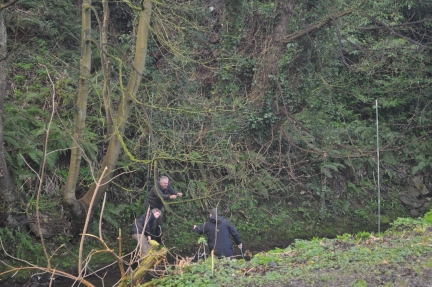This blog usually focuses on all issues marine… however last week I had the opportunity to accompany one of my colleagues on her field excursions and I leapt at the chance to try terrestrial ecology for the first time. I say terrestrial, but strictly speaking this post is on all things avian!
A selection of my birdy photos (magpie in Belfast, oystercatcher in Larne and heron in Tokyo)
The PhD office where I am usually based is always filled with people researching a huge variety of subjects under the umbrella of ecology, including studies assessing bats and windfarms, jellyfish blooms and the bush meat trade. Siobhán Porter is one of my close friends and colleagues, and her PhD focuses on hedgerow birds and national agricultural policy. During her spare time, she is also working towards gaining a bird ringing licence, which is a scientific survey method that I know very little about. As one of my particular interests is tagging and tracking of large marine species, assessing population movements of birds sounded fascinating! How do you attach metal bands to something so small and fragile, with no water to support the weight?! After asking quite a few questions about the process, she invited me to come along on a ringing session and see how it was done…
Mallard duck and robin red-breast (later credit Lawrence Eagling, for further amazing photography check out his website EaglingPhotography.co.uk)
People have been ringing birds in the UK and Ireland since the early 1900’s, with over 3,000 registered volunteers currently helping to ring over a million birds each year. But why? Well, the main aim of the bird ringing project is to study bird movements and migration patterns whilst assessing population changes. The BTO (British Trust for Ornithology), organises dedicated training sessions lead by experienced, licenced ringers to pass on the delicate skills required to safely catch, measure and ring birds of all species and sizes. The rings themselves are lightweight metalbands that encircle the bird’s foot with a unique number. This number is recorded along with each bird’s weight, and length measurements which will be updated if/when it is recaptured. This information can enable scientists to calculate vital statistics on each species to be used in population monitoring and management strategies including: estimates of species abundance, age maxima, movement and migration, site fidelity and homing ability.
Moorhen and a little flock of turnstones
Siobhán showed me how the volunteers set up fine “mist” nets (a bit like super fine fishing net), strung between trees and across streams. The ground around the nets was scattered with seed and then the volunteers retreated to a place where the nets could be monitored without scaring any birdlife. The nets across the stream were particularly important as we were hoping to ring dippers and kingfishers which use the stream gullies as miniature highways through the countryside!

Setting up the mist nets (I can’t see them either…)
Unfortunately after 4 hours we were forced to conclude it was a poor day for birds, as the bright sunshine illuminated the nets and a succession of dog walkers along the stream meant that the site was rarely quiet… however I was lucky enough to be at the nets when a tiny little wren was caught (see photos!) I have never seen a bird so close before, held carefully in trainer Aiden Crean’s hands and it was incredible to see the details of each feather blade interlocking to create the smooth feathered wings. The passion of the volunteers for their work was infectious, early starts and cold weather were totally disregarded in the presence of the tiny bird added to the database. The measurements collected by this dedicated group form a vital collection for scientific analysis to monitor and protect our amazingly diverse birdlife.
A couple of close ups of our wren
I am very grateful for the Belfast and Down ringing group for such access to their delicate work, and I hope to accompany them again shortly to learn more about their research. If you would like further information on bird ringing or would like to volunteer to help the recording effort, the BTO website has some great material at: http://www.bto.org/volunteer-surveys/ringing/about








